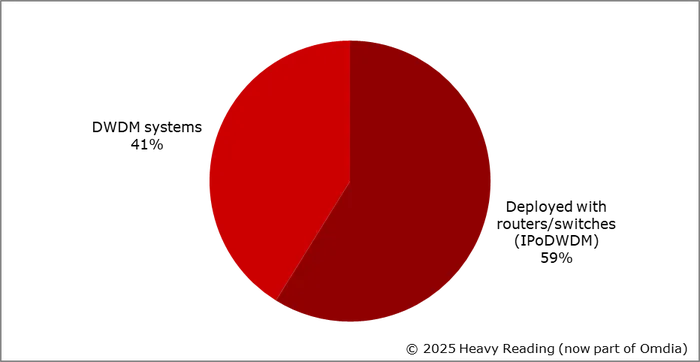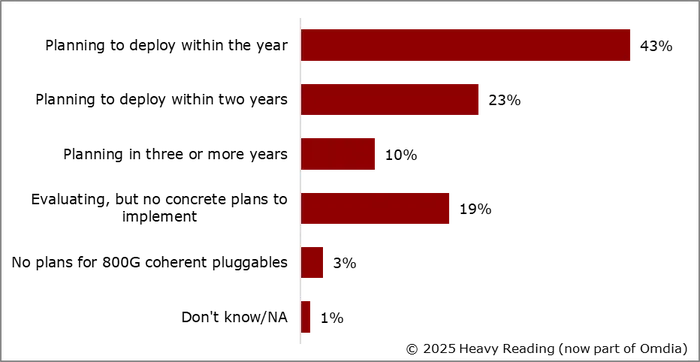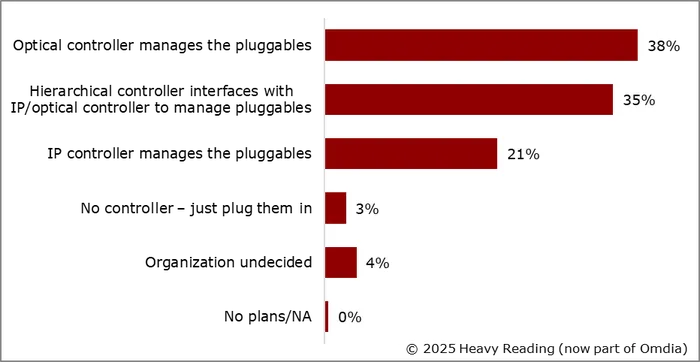The results of a Heavy Reading (now part of Omdia) global survey of IPoDWDM adoption among CSPs highlight the importance of hardware and software innovations.
It is well-known that 400ZR coherent pluggable optics launched the market for coherent pluggable optics in routers — commonly called IP over DWDM (IPoDWDM) or coherent routing. Hyperscalers have led the charge, but Heavy Reading (now part of Omdia) has been keenly tracking the uptake of IPoDWDM among communications service providers (CSPs). Working with Ciena, we completed our largest ever global survey of IPoDWDM adoption, specifically targeting CSPs.
This blog highlights key findings from the February 2025 survey of 240 global respondents.
Increasing enthusiasm
One nuance of coherent pluggable optics sometimes overlooked is that they can be housed both in traditional optical transport systems and in routers and switches (i.e., IPoDWDM). Heavy Reading (now part of Omdia) survey data continues to show that both applications are significant to network operators, but the tide is steadily shifting toward IPoDWDM architectures.
CSPs surveyed predict that, in three years, 59% of their 400G+ pluggables will be used in IPoDWDM equipment, and 41% will be housed in traditional transport gear. The current figures are a near reversal of the data from a similar question asked in a 2022 Heavy Reading (now part of Omdia) survey. In that 2022 survey, the data broke down as 61%/39% in favor of traditional optical transport systems.
Heavy Reading analyst Sterling Perrin sits down with Ciena’s Sr. Director of Product Line Management, Rafael Francis, and VP, Product Line Management, Tim Pearson, to review the survey findings and what they mean for the future of coherent routing in telecom.
Digging further, within traditional DWDM systems, network operators expect pluggables to be evenly distributed across metro and long-haul networks. In IPoDWDM, they expect a slightly greater distribution of 400G+ optics in metro networks versus long-haul networks.
By the end of 2027, how do you see the distribution of 400G+ coherent pluggable optics in your network for various applications?

Hardware evolution
Network operators seek a balance between standardization and higher performance transmission modes (i.e., non-standardized) when selecting coherent pluggable optics. 52% of operator respondents are "extremely willing" to use proprietary optics to gain performance advantages, and an additional 38% are "somewhat willing" and will evaluate proprietary modes on a case-by-case basis. It is clear that network operators require a mix of standard and proprietary modes in their modules; they will choose what works best for each application.
With OIF 800ZR standardization completed in October 2024 and a large base of module suppliers at the outset, 800G coherent pluggable optics is a hot topic. Near-term interest in deploying 800G coherent pluggables optics is high. 43% of respondents plan to deploy 800G coherent plugs within a year, and an additional 23% plan to deploy 800G coherent pluggables within two years. 19% are evaluating the option, while just 3% have no 800G plans.
The timelines seem aggressive, but 800G line rates may not always be the goal. Many network operators are interested in using the new-generation optics to achieve greater reach at 400G data rates.
Significantly, as they plan for 800G pluggable optics, operators are also looking to upgrade the routers that will house them. In some cases, the migration to 800G-capable routers is proceeding ahead of the migration to the optics themselves. For any router refresh cycle, 800G-capable ports will be front and center in requirements — even if there are no immediate plans to use the optics.
When will you deploy 800G coherent pluggable optics in your network?

Software evolution
Comparing the top drivers and challenges for IPoDWDM adoption, there are some concerns. Operators are migrating to IPoDWDM for operational simplicity and efficiency (among other reasons), but operational complexity also stands in the way of adoption — particularly for the multi-vendor optical networks that are the end goal for many.
Here, the software aspects of IPoDWDM play crucial roles. These include consistent operations across pluggables, open APIs for managing pluggables and multi-vendor control that covers both IPoDWDM and traditional transport.
Under the broader topic of pluggables management, choosing the right controller strategy is a key topic of interest and an ongoing debate. In this survey, 38% reported they prefer optical controllers to manage pluggables, with hierarchical controllers a close second (preferred by 35%). At 21%, a significant minority prefer IP controllers to manage the pluggables.
Managing the optical layer is complex, and the data suggests many operators prefer the expertise of their optical teams for this function. Heavy Reading (now part of Omdia) continues to find, however, that the role a respondent plays within an organization is a major factor in controller preferences. Optical teams prefer optical control of pluggables, while IP teams prefer IP control. We expect this to be a continuing area of debate within the industry and within operators themselves.
What is your preferred strategy for managing coherent pluggables in routers?

There have been several false starts along the long road to IP and optical convergence, and Heavy Reading (now part of Omdia) has been a skeptic at times. However, the pattern of our CSP surveys conducted over the past five years shows a clear trend of increasing prioritization. IP and optical convergence is here.
This blog originally appeared on LightReading.com.






